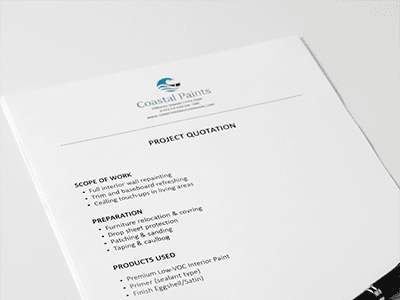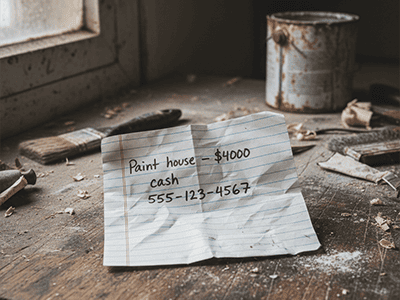How to Compare Painting Quotes
A Guide to Understanding the Price and Spotting Red Flags
You’ve decided to hire a professional painter, and you’ve done the right thing by getting multiple quotes. Now you’re sitting with two or three pieces of paper with wildly different prices, and you’re left wondering why. The cheapest quote is tempting, but is it the best value? A painting quote is much more than just a final number; it's a window into the contractor's professionalism, process, and the quality of the job you can expect. Understanding how to read a quote properly will help you make an informed decision and avoid the costly mistake of a cheap job that fails in a year.
The Anatomy of a Good Quote
A professional, detailed quote is a sign of a professional, detailed painter. It should leave you with no questions. Look for the following sections:

- Company Details: It must clearly show the business name, ABN, and contractor's licence number. This is a non-negotiable sign of a legitimate business.
- Scope of Work: It should clearly and specifically list every area to be painted (e.g., "Living Room: walls, ceiling, one door, all skirting boards and architraves"). Vague terms like "paint room" are a red flag.
- Preparation Process: This is critical. A good quote will itemise the prep work, including phrases like "Cover all floors and furniture," "Wash all surfaces," "Fill cracks and holes," "Sand all surfaces," and "Spot prime repairs."
- Products to be Used: The quote must specify the brand and exact product line of the paint to be used (e.g., "Dulux Wash&Wear Low Sheen" for walls, "Dulux Aquanamel Semi-Gloss" for trim). It should also state how many coats will be applied (the standard is two topcoats).
- Inclusions and Exclusions: It should be clear about what is and isn't included. Does the price include the paint? Does it cover significant plaster repairs?
- Price and Payment Terms: The total price including GST should be clearly stated, along with the payment schedule (e.g., deposit, progress payments, final payment on completion).
- Warranty Information: A professional will often include details of their workmanship warranty.
Red Flags: How to Spot a Bad Quote
The cheapest quote often becomes the most expensive one when you have to pay someone else to fix it in a couple of years. Be very wary of quotes that exhibit these warning signs.

- It’s Vague and Lacks Detail: If the quote is a single line on the back of a business card saying, "Paint three-bedroom house: $5,000," run away. This is the biggest red flag. There is no detail, no accountability, and no guarantee of quality.
- It's Significantly Cheaper Than the Others: A dramatically lower price is a sign that corners are being cut. This usually means inadequate preparation, the use of cheap, low-quality paint, only applying one coat instead of two, or using an unqualified, uninsured crew.
- No ABN or Licence Number: This indicates an uninsured, "cash-in-hand" operator. If something goes wrong, you will have absolutely no recourse.
- No Mention of Paint Brand or Prep Work: If the quote doesn't commit in writing to proper preparation and the use of premium paint, you can be almost certain you won't be getting it.
- A Large Upfront Deposit is Demanded: A small deposit (typically 10%) is standard practice. A contractor demanding 50% or more upfront may have cash flow problems or, in the worst-case scenario, may not be intending to finish the job.
Pro Tip from a Sydney Painter
Your decision should be based on value, not just price. A well-prepared, professionally executed paint job using premium materials will outlast a cheap job by many years. Think of it this way: the price of a quote reflects the time, skill, and quality of materials that will be invested in your home. At DRJ Painting, we provide fully detailed, transparent quotes that clearly outline every step of our high-quality process, so you can be confident you’re investing in a superior, long-lasting finish.

